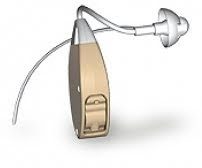Myth - Only elderly people need a Hearing Aid.
Fact - Although hearing loss is most common in the elderly due to the receptors in the inner ear becoming less responsive, there are many younger children and middle aged people who suffer some hearing loss which can be due to damage to the ear through trauma to the ear or listening to loud sounds. Hearing loss can also be due to a person being born with a slight deformity in the ear.
Myth - I have been told that my hearing loss cannot be helped as it is permanent.
Fact - All forms of hearing loss can be helped unless the sufferer is completely deaf.
Myth - If I suffered from hearing loss wouldn’t I know about it.
Fact - Most hearing loss in the elderly develops over a number of years and therefore as it is a very slow change it is not immediately recognised by the sufferer. It is more likely to be noticed by family and friends in such things as asking for the TV or radio to be turned up.
Myth - I will be able to hear perfectly when I wear a Hearing Aid.
Fact - Hearing Aids can never return your hearing to normal. Depending on the severity of your hearing loss, the environment and your own particular needs, such as taking part in conversations etc, will determine how the Hearing Aid is programmed to overcome your particular hearing loss.
Myth - I wont be able to hear all the natural sounds such as birds singing if I fit a Hearing Aid.
Fact - Digital Hearing Aids can now be programmed according to sufferer’s personal requirements. Some may want to cut out background noises so they can hear a conversation in a crowded restaurant. Whereas others still want to hear what is going on around them and just want to have improved hearing.
Myth - If I wear a Hearing Aid everyone will know about it.
Fact - There are now Hearing Aids that are almost undetectable. These are called `Completely in the Channel` and as the name suggests they fit completely in the ear channel and are almost invisible. Other Hearing Aids such as the ` Behind the Ear` types are now being made must smaller especially the BTE Open Fit type.
Myth - I don’t know anybody with a Hearing Aid so it can`t be much of a problem.
Fact - It is estimated that there are over 2 million people who wear a Hearing Aid and it is believed that another 6 million would benefit from one, especially people over the age of 65 years. It has been long accepted that people with defective eyesight will quite readily wear spectacles but those with defective hearing fight shy of doing the same with Hearing Aids.
Myth - If I wear a Hearing Aid my ears will be blocked up.
Fact - Most Hearing Aids do have an ear mould that completely seals the ear channel, there are now new Digital Hearing Aids which do not use an ear mould, these are called ` Open Fit hearing Aids` These allows the ear channel to be left open but still receive the amplified sounds from the Hearing Aid.
Myth - I have head that you get a lot of problems when you wear a Hearing Aid.
Fact - When you first wear a Hearing Aid it will take a lot of getting used to. The initial setup may not have been suitable or the type of Aid was not right for you. It is always worth persevering with the new Aid as your hearing will very quickly attune to it.
Myth - I have been told that I will have to keep returning to my Hearing Specialist to have my Aid programmed.
Fact - If you buy your Hearing Aid from an Audiologist it is generally the case that you will have to return to him to have the Aid reprogrammed. There are programmers on the market that allow you to programme your own Hearing Aid
Subscribe to:
Post Comments (Atom)

Very useful and informative post, thanks for sharing these myths and facts about hearing and hearing aids. These will definitely help.
ReplyDeleteRegards,
hearingaids